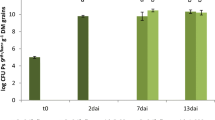Abstract
Pseudomonas cepacia, a common soil and rhizosphere inhabitant, showed strong antagonism against several fungal plant pathogens. In dual cultures it greatly restricted the growth and conidial formation in several of these fungi. Growth restriction was associated with the frequent induction of a variety of morphological abnormalities such as chlamydoconidium formation, hyphal swellings, vacuolation and granulation of the mycelial contents, as well as lysis of hyphae and conidia. The induction of these deleterious morphological changes in fungi and inhibition of conidial formation were also found with a crude preparation of an antifungal compound fromP. cepacia. Mutants, defective in the production of this antifungal compound, failed to induce these morphological changes; this suggests that the antifungal compound is responsible for these abnormalities.
Similar content being viewed by others
Literature Cited
Anderson RC, Liberta AE (1986) Occurrence of fungal-inhibitingPseudomonas on caryopses ofTripsacum dactyloides L. and its application for seed survival and agricultural application. J Appl Bacteriol 61:195–199
Becker LO, Cock RJ (1988) Role of siderophores in suppression ofPythium species and production of increased growth response of wheat by fluorescent pseudomonads. Phytopathology 78:778–782
Fantanio MG, Bazi C (1982) Antagonistic effect ofPseudomonas cepacia againstFusarium oxysporum. Informat Fitopathol 32:55–58
Homma Y, Stao Z, Hirayama F, Konno K, Shiraham H, Suzui T (1989) Production of antibiotics byPseudomonas cepacia as an agent for biological control of soil-borne plant pathogens. Soil Biol Biochem 21:723–728
Janisievicz WJ, Roitman J (1988) Biological control of blue mould and gray mould on apple and pear withPseudomonas cepacia. Phytopathology 78:1697–1700
Jayaswal RK, Fernandez MA, Schroeder RG (1990). Isolation and characterization of aPseudomonas cepacia strain that restricts growth of various phytopathogenic fungi. Appl Environ Microbiol 56:1053–1058
Kloepper JW, Leong J, Teintze M, Schroth MN (1980)Pseudomonas siderophores: a mechanism explaining disease suppressive soils. Curr Microbiol 4:317–320
Kloepper JW, Leong J, Teintze M, Schroth MN (1980) Enhanced plant growth by siderophores produced by plant growth promoting rhizobacteria. Nature (London) 286:885–886
Lambert B, Leyns F, Joos S, Tenning P, van Rijbergen R, van Outryve F, Zhao Y, Swings J, van Montagu M (1987) Rhizobacteria with broad spectrum of antifungal activity. Bull Eppo 17:601–607
Lee WH, Kobyashi K (1980) Isolation and identification of antifungalPseudomonas sp. from sugar beet roots and its antibiotic products. Korean J Plant Path 4:264–270
Leong J (1986) Siderophores: their biochemistry and possible role in biocontrol of plant pathogens. Annu Rev Plant Pathol 24:187–209
Livens KH, van Rijbergen R, Leyns FR, Lambert BJ, Tennings P, Swings J, Joos HJ-P (1989) Dominant rhizosphere bacteria as source for antifungal agents. Pest Sci 27:141–154
Meyer J-M, Hohonadal D, Halle F (1989) Cepabactin fromPseudomonas cepacia, a new type siderophore. J Gen Microbiol 135:1479–1487
Misaghi IJ, Olsen MW, Cotty PJ, Donndelinger, CR. (1988) Fluorescent siderophore mediated iron deprivation—a contingent biological control mechanism. Soil Biol Biochem 20:573–574
Parke JL (1990) Population dynamics ofPseudomonas cepacia in the pea spermosphere in relation to biological control ofPythium. Phytopathology 80:1307–1311
Schroth MN, Hancock JG (1982) Disease-suppressive soils and root colonizing bacteria. Science 216:1376–1381
Upadhyay RS, Visintin L, Jayaswal RK (1991) Environmental factors affecting the antagonism ofPseudomonas cepacia againstTrichoderma viride. Can J Microbiol, in press
Vandenbergh PA, Gonzalez CF, Wright AM, Kunka BS (1983) Iron-chelating compounds produced by soil pseudomonads: correlation with fungal growth inhibition. Appl Environ Microbiol 46:128–132
Weller DM, Cook RJ (1985) Suppression of root diseases of wheat by fluorescent pseudomonads and mechanism of action. In: Swinburne TR (ed) Iron, siderophores, and plant disease. New York: Plenum Publishing Corp, pp 000-000
Author information
Authors and Affiliations
Rights and permissions
About this article
Cite this article
Upadhyay, R.S., Jayaswal, R.K. Pseudomonas cepacia causes mycelial deformities and inhibition of conidiation in phytopathogenic fungi. Current Microbiology 24, 181–187 (1992). https://doi.org/10.1007/BF01579279
Issue Date:
DOI: https://doi.org/10.1007/BF01579279




